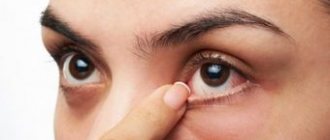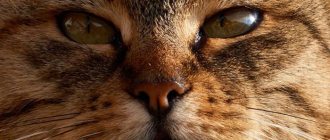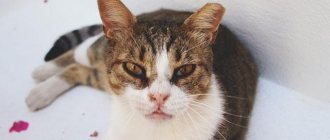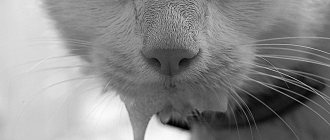Eye diseases causing redness
The following diseases can contribute to the appearance of such a symptom:
- Blepharitis. The disease is accompanied by inflammation of the eyelid skin caused by bacteria or fungi. May occur due to an allergic reaction or injury. Blepharitis is accompanied by swelling and baldness of the eyelids, squinting, frequent blinking, itching, mucous or purulent discharge.
- Conjunctivitis. The disease is of viral or bacterial origin. In the latter case, the inflammatory process is characterized by an abrupt onset and rapid course. The clinical picture of viral conjunctivitis develops more slowly. In this case, purulent discharge does not always appear. Liquid mucus may be released from the conjunctival sac, which does not stick the eyelids together after sleep. This makes diagnosis very difficult. In the bacterial form of inflammation, thick purulent discharge sticks the eyelids together. The redness is mild.
- Glaucoma. The disease is characterized by an increase in intraocular pressure. It is diagnosed frequently. The sclera in cats turns red due to vasodilation. An enlarged pupil does not respond well to light. The cat tries to stay in dark rooms. The cornea and lens become cloudy, the eyeball enlarges. The appearance of red around the eyes of a cat is accompanied by swelling and incomplete closure of the eyelids. The animal experiences pain, orientation in space is disturbed, and the cat’s vision deteriorates.
- Entropion. The disease is characterized by inward turning of the eyelids. Eyelashes irritate the eye shell and injure it. Acute pain and lacrimation occur, the skin becomes red, the eye becomes red, and blepharospasm immediately appears - involuntary movement of the eyelids. If left untreated, the corneal tissue becomes inflamed.
- Entry of a foreign body. A grain of sand, wood shavings or splinter falls on the surface of the eyeball, injuring it. The animal's eyelids swell and turn red, the cat is in severe pain, and the pet does not allow its head to be touched.
- Uveitis. In the early stages, the symptoms of the disease are similar to those of conjunctivitis. The conjunctiva turns red, signs of irritation appear, and the pupil stops responding to light. Lacrimation is combined with the discharge of pus or mucus. A pink rim appears around the eyeball. White spots are found on the cornea, the color of the iris changes. The non-infectious form of the disease may be accompanied by allergic rhinitis.
Common Causes
A symptom in which the eyes cut and water can occur for the following reasons:
- Long-term eye strain , which occurs when constantly working at a computer or reading for a long time.
- Staying for a long time in dry air conditions (for example, in a room with air conditioning).
- Insufficient lighting or lack of natural light in the room.
- Diseases of inflammatory or infectious origin.
- Injuries and damage to the organs of vision , including foreign bodies entering the eyes and thermal or chemical burns.
- Allergic reactions upon contact with various allergens (in such cases, the symptom may occur at certain times of the year or when certain irritants come into contact with the eyes).
Keep in mind! The eyes often sting and watery eyes in people who wear contact lenses.
In such cases, the cause may be either increased sensitivity of the mucous membrane and cornea to such optics, or improper use of lenses (wearing expired optics, incorrectly selected lenses, using lenses for longer than the specified time and at night).
Diagnosis of diseases
To identify diseases accompanied by irritation and redness of a cat’s eyes, an examination is used, including:
- Assessment of visual functions. Helps determine whether an animal’s vision is impaired or not.
- Appearance assessment. At this stage, signs of the disease are revealed - changes in the size and shape of the pupil, reduction of the palpebral fissure, redness and inflammation of the eyelids, traumatic changes.
- Identification of signs of damage to the eyeball. The size, shape, and presence of foreign bodies on the surface of the sclera are determined.
Treatment for red eyes in cats
For the treatment of eye diseases in cats, the following is used:
- Antiseptic solutions. If the animal's eyes are watery or purulent, they are washed with Furacilin solution. 1 tablet is dissolved in 200 ml of boiled water. A cotton swab is moistened with the liquid and used to wipe the eyes. The drug can be replaced with a light pink solution of potassium permanganate.
- Local antibiotics. Levomycetin or Gentamicin is instilled after primary treatment. The recommended single dose for an adult cat is 1 drop. Albucid is not recommended for use in treating animals; the drug causes a burning sensation. After administering the drops, the cat is held in your arms, which helps to avoid licking the medicine. Drops can be replaced with tetracycline, erythromycin or neomycin ointment.
- Healing agents. A small amount of Solcoseryl gel is placed behind the eyelid 2 times a day. The drug helps cope with irritation and the consequences of injuries.
- Systemic antibiotics. Cefazolin is used for eye diseases. The contents of the bottle are dissolved in 5 ml of novocaine. The drug is administered intramuscularly, the dosage depends on the weight and age of the animal.
- Antihistamines (Suprastin). Injections are given when allergic reactions to antibiotics occur.
- Folk remedies. A decoction of chamomile, oak bark or sage can be used for red eyes in kittens. 1 tbsp. l. Boil the herbs in 200 ml of water for 10 minutes. The product is cooled, filtered and used to treat the eyes 3-4 times a day.
In severe cases of the disease, surgical intervention is performed.
Is treatment possible at home without veterinary care?
Before you start treating your kitten at home, you need to take him to an appointment with a veterinarian. It is very important to find out the real cause of inflammation. If it is accompanied by a general deterioration in health, sneezing, coughing, and upset bowel movements, the pet may be seriously ill.
Some dangerous diseases, such as calcivirosis or viral rhinotracheitis, often occur with symptoms of damage to the organs of vision. The veterinarian will examine the pet, take tests and make a diagnosis. If a serious infectious disease is detected, eye drops alone cannot be used; complex treatment will be required.
Attention! You can treat a kitten at home only after examination at a veterinary clinic.
How and what to wash a kitten's eyes with
Washing the eyelids is the first thing to do if the inflammatory process begins. You need to carefully remove crusts and discharge with a cotton pad. It is moistened in warm boiled water, saline or strong tea without additives. Each eye is wiped with a clean swab in the direction from the outer corner to the inner. On each side you will need 5-6 cotton pads or gauze pads. Do not dip a dirty swab into the rinsing solution.
Washing a kitten's eyes
A strong infusion of chamomile can also be used to cleanse crusts and pus from the eyelids. This remedy helps relieve inflammation. For brewing, it is better to take the flowers of the plant in bags. For 1 cup of boiling water you will need 4 bags of chamomile. Before using the infusion, it is important to make sure that it is not hot. The washing procedure is done 4–5 times a day.
How to put eye drops on your pet correctly
Dealing with a sick pet, even if it is small, is not so easy. The animal will resist treatment procedures. You may need an assistant to secure your four-legged friend. The cat is placed on its back and its paws are held down. A second person carefully removes the pus from the eyelids. Only after this can you use the drops.
The lower eyelid is pulled back slightly with the thumb, fixing the cat’s head so that it does not twitch. The bottle is kept at a distance of 1 cm from the eyeball, the dropper should not touch the eyelid. Inject the required amount of solution into the formed pocket. Next, do the same with the second eye.
Putting eye drops on a cat
Prevention of eye diseases
Prevention of eye diseases in cats includes:
- Regular cleansing of the visual organs from natural secretions. Mucus that accumulates in the corners of the eyes becomes a good breeding ground for bacteria, which causes infectious conjunctivitis to develop.
- Avoid getting hair in the eyes. This problem affects long-haired animals. The hairs irritate the white of the eye, leaving scratches.
- Treatment of tear ducts. The area along the cat's nose is wiped with a cotton swab. This prevents the tear fluid from drying out.
- Proper implementation of hygiene procedures. When bathing an animal, do not allow detergents to get into the eyes. This also applies to insecticidal solutions used to treat cats against skin parasites at home. The products cause burns that contribute to redness of the eyes.
- Timely administration of vaccinations. Vaccination protects the animal from infections that cause eye diseases.
- Treatment of helminthic infestations. Parasitic worms produce toxins that can provoke negative reactions of the immune system, including allergic conjunctivitis.
The cat should be shown to the veterinarian at least once every six months.
All information posted on the site is provided in accordance with the User Agreement and is not a direct instruction to action. We strongly recommend that before using any product, you must obtain a face-to-face consultation at an accredited veterinary clinic.
First aid and prevention
Why do my cats always have red eyes? The reason is different in each specific case. The syndrome may be a consequence of violation of the rules for caring for the animal, or it may be a symptom of a serious illness. Therefore, if the redness does not go away for a long time, you should not delay a visit to the veterinarian. Only he can make a high-quality diagnosis, assess the pet’s condition and determine further treatment tactics.
If the owner does not have the opportunity to immediately go to the clinic, you can use first aid techniques for ophthalmological problems. They will help alleviate the pet’s condition somewhat and, in some cases, have a therapeutic effect.
- It is necessary to put a protective collar on the neck of a cat or kitten, which will prevent them from touching their eyes with their paws, and therefore prevent the risk of secondary infection.
- You should regularly remove discharge from the eyes and rinse them with cotton pads soaked in warm boiled water or a strong solution of tea leaves.
- To reduce the inflammatory reaction, you can instill antiseptic eye drops or an “artificial tear” drug.
- Hair hanging over the eyes should be trimmed more often so that it does not injure the cornea.
If you ignore a symptom such as redness of the eye sclera, you may miss the onset of a serious illness in your cat. It’s better to play it safe and take your pet to the veterinarian as soon as possible for an examination and consultation, so that you don’t have to regret the lost time later.










